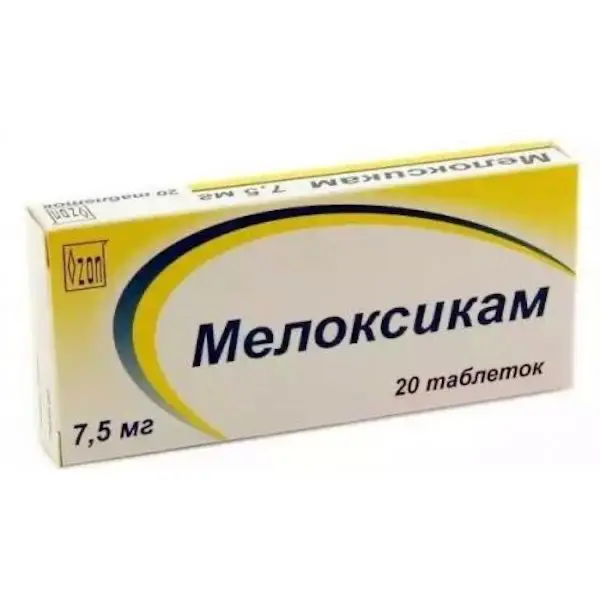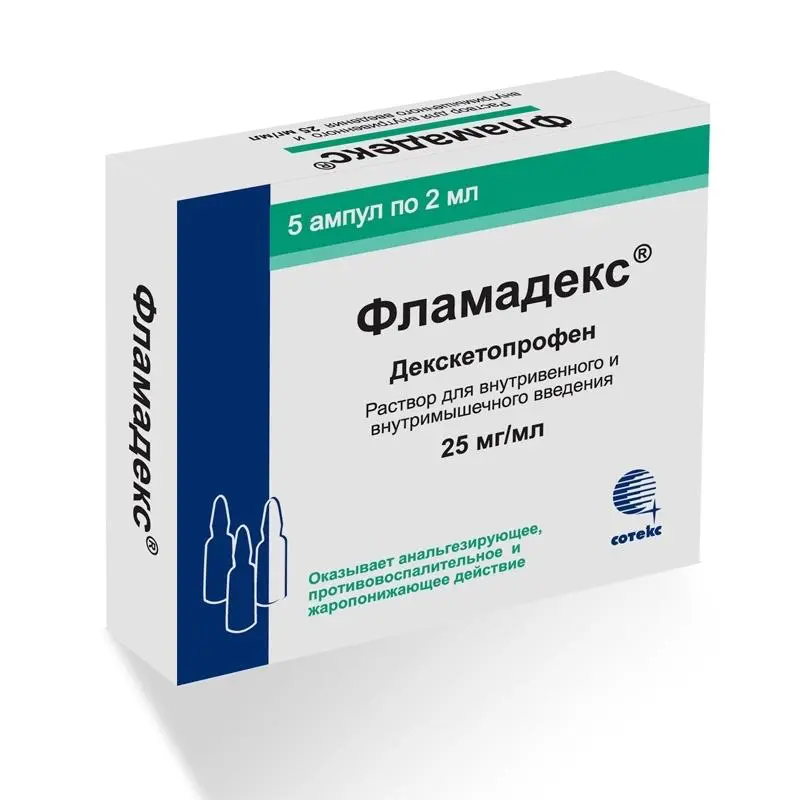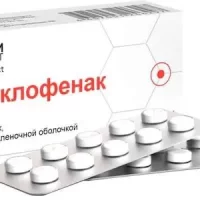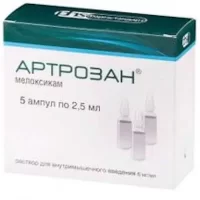Description
Meloxicam Pharmacodynamics
The drug Meloxicam is a non-steroidal anti-inflammatory drug, refers to enolic acid derivatives and has anti-inflammatory, analgesic and antipyretic effects. The pronounced anti-inflammatory effect of meloxicam has been established in all standard models of inflammation.
The mechanism of action of meloxicam is its ability to inhibit the synthesis of prostaglandins – known mediators of inflammation.
Meloxicam in vivo inhibits the synthesis of prostaglandins at the site of inflammation to a greater extent than in the gastric mucosa or kidneys.
These differences are associated with more selective inhibition of cyclooxygenase-2 (COX-2) compared to cyclooxygenase-1 (COX-1). Inhibition of COX-2 is thought to provide the therapeutic actions of NSAIDs, whereas inhibition of the ever-present COX-1 isoenzyme may be responsible for gastric and renal side effects. The selectivity of meloxicam against COX-2 has been confirmed in various test systems, both in vitro and in vivo. The selective ability of meloxicam to inhibit COX-2 was shown when used as a test system of human whole blood in vitro. It was found that meloxicam (at doses of 7.5 and 15 mg) more actively inhibited COX-2, having a greater inhibitory effect on the production of prostaglandin E2, stimulated by lipopolysaccharide (COX-2-controlled response), than on the production of thromboxane involved in blood clotting (COX-1-controlled response). These effects were dose-dependent. In ex vivo studies, meloxicam (in doses of 7.5 mg and 15 mg) has been shown to have no effect on platelet aggregation and bleeding time.
In clinical trials, gastrointestinal (GI) adverse reactions (HP) were generally less frequent with meloxicam 7.5 and 15 mg than with the other NSAIDs compared. This difference in the incidence of gastrointestinal HP was mainly due to the fact that dyspepsia, vomiting, nausea, and abdominal pain were observed less frequently while taking meloxicam. The frequency of upper GI perforations, ulcers, and bleeding associated with the use of meloxicam was low and depended on the dose of the drug.
Indications
Symptomatic treatment:
– Osteoarthritis (osteoarthritis, degenerative joint disease), including with a pain component;
– rheumatoid arthritis;
– ankylosing spondylitis;
– juvenile rheumatoid arthritis (in patients with body weight ≥ 60 kg);
– Other inflammatory and degenerative musculoskeletal diseases such as arthropathies, dorsopathies (e.g. sciatica, lower back pain, shoulder periarthritis, and others) accompanied by pain.
Contraindications
– Hypersensitivity to the active substance or excipients of the drug;
– Complete or incomplete combination of bronchial asthma, recurrent polyposis of the nose and sinuses, angioedema or urticaria, caused by intolerance to acetylsalicylic acid or other NSAIDs due to the existing possibility of cross-sensitivity (including history);
– Erosive-ulcerative lesions of the stomach and duodenum in the acute stage or recently suffered;
– Inflammatory bowel disease – Crohn’s disease or acute ulcerative colitis;
– Severe hepatic insufficiency;
– Severe renal failure (unless hemodialysis, creatinine clearance (CK) less than 30 ml/min, and confirmed hyperkalemia), advanced renal disease;
– Active gastrointestinal bleeding, recent cerebrovascular bleeding or established diagnosis of clotting disorders;
– Severe uncontrolled heart failure;
– Pregnancy;
– Breastfeeding period;
– Perioperative pain therapy for coronary artery bypass grafting;
– Rare hereditary galactose intolerance, lactase deficiency, glucose-galactose malabsorption (maximum daily dose of meloxicam 7.5 mg and 15 mg contains 67 mg and 134 mg of lactose, respectively).
Dosage and administration
- Osteoarthritis with pain syndrome: 7.5 mg per day. If necessary this dosage may be increased to 15 mg per day.
- Rheumatoid arthritis: 15 mg per day. Depending on the therapeutic effect, this dose may be reduced to 7.5 mg per day.
- Ankylosing spondylitis: 15 mg daily. Depending on the therapeutic effect, this dose may be reduced to 7.5 mg per day.
- Juvenile rheumatoid arthritis: 7.5 mg per day.
- Increasing the dose of the drug above the recommended daily dose does not increase its effectiveness. Available doses of the drug Meloxicam tablets do not allow taking the drug in patients with body weight less than 60 kg.
- Special groups of patients
- Children
The efficacy and safety of the drug Meloxicam in children younger than 12 years, for indications other than juvenile rheumatoid arthritis, has not been studied. - Patients with an increased risk of HF (history of GI diseases, presence of cardiovascular risk factors)
- It is recommended to start treatment with a dose of 7.5 mg per day (see “Special Instructions”).
- Patients with renal insufficiency
- In patients with significant renal impairment who are on hemodialysis, the dose should not exceed 7.5 mg per day.
- No dose adjustment is required in patients with mild to moderate renal failure (creatinine clearance greater than 25 ml/min).
- Patients with impaired liver function
In patients with liver cirrhosis (compensated), no dose adjustment is required. - General guidelines
Since the potential risk of HP depends on the dose and duration of treatment, the lowest possible dose and the shortest possible duration of use should be used. The maximum recommended daily dose is 15 mg. - Combined use
Do not use simultaneously with other NSAIDs.
The total daily dose of meloxicam used in different dosage forms should not exceed 15 mg. - The daily dose of the drug should be taken in a single dose, with a meal, with water or other liquids.
- Insufficient information is provided on the effect of mixing crushed tablets with food or liquid.
- For 7.5 mg tablets, the risk per tablet does not allow the 7.5 mg tablet to be divided into two equivalent half doses. The tablet can only be split in half to make it easier to swallow.





